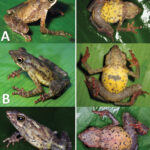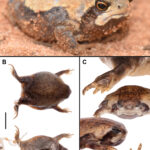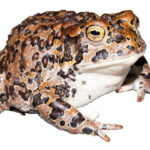Atelopus laetissimus: Exploring the Vibrant World of the Joyful Harlequin Frog#
Beneath the lush canopy of Colombia’s misty mountains, among vibrant bromeliads clinging to towering trees and the rhythmic chorus of countless forest creatures, lives a small amphibian whose vibrant colors and lively demeanor have captured both scientific curiosity and local folklore. Meet Atelopus laetissimus, affectionately known as the joyful harlequin frog. This species, a vibrant jewel of tropical cloud forests, boasts one of nature’s most conspicuous arsenals—remarkable coloration designed to warn predators of its potent toxins, alongside a captivating life history that underscores the fragile balance of its ecosystem.
Despite its enchanting aesthetics, Atelopus laetissimus faces considerable threats due to habitat loss, climate change, and disease, factors that have made this spectacular little creature a focal point for conservation. As we journey deeper into this frog’s remarkable existence, we learn not just about one amphibian species—but about the importance of maintaining healthy, thriving habitats essential for wildlife across the globe.
Taxonomy and Classification#
To fully appreciate the joyful harlequin frog, it’s essential to understand its taxonomic identity. Scientifically named Atelopus laetissimus, the species belongs to the Bufonidae family, which encompasses the diverse group we commonly know as true toads. However, the genus Atelopus distinguishes itself from its more familiar relatives through distinct characteristics such as vibrantly detailed skin patterns, smooth textures, and a unique posture.
This genus contains numerous eye-catching species collectively referred to as harlequin frogs. Many of these tiny amphibians, including ours in question, showcase vivid, often neon-like coloration serving as a warning of their toxicity—a clever evolutionary strategy known as aposematism. Close relatives of Atelopus laetissimus—like the critically endangered golden harlequin frog (Atelopus zeteki)—share similar bright coloration patterns, emphasizing the evolutionary road map that nature has refined over millennia.
Natural Habitat#
Atelopus laetissimus is native to Colombia’s richly biodiverse Sierra Nevada de Santa Marta mountain range, beside humid montane forests that drape gracefully across steep slopes and valleys. This amphibian thrives in pristine, fast-flowing mountain streams, where pristine, oxygen-rich waters create ideal breeding grounds and nurseries for tadpoles.
This habitat—the cloud forest—is among Earth’s most climatically stable yet ecologically specialized ecosystems. Beneath heavy layers of mist and rain, lush undergrowth provides moisture and shelter, while canopies filter light to form an environment magnificently suited to these frogs. Bromeliad and fern-adorned trunks offer refuge and hunting grounds, while nearby streams are integral to reproduction and development.
Integral to their survival, these environments are delicate and vulnerable to disturbances such as deforestation, agricultural expansion, or changes in climate that alter rainfall patterns—a reality threatening the ongoing survival of our joyful harlequin friend.
Physical Characteristics#
The joyful harlequin frog hardly exceeds three centimeters in length, yet its brilliant appearance captures attention far beyond its modest physical size. Vivid hues of electric greens, dazzling yellows, and striking black markings pattern its skin, forming an unmistakable outfit. This coloration is more than mere decoration; rather, it serves an essential ecological function—warning predators of potent toxins produced by glands beneath the frog’s skin.
The smooth skin texture, atypical for members of its family, makes Atelopus laetissimus notably different from typical warty toads. Its elongated limbs, slender digits, and agile build lend it particular climbing and jumping capacities, helpful both to maneuver along rough terrain and to evade predators swiftly. Such adaptations enable this frog to successfully navigate complex microhabitats high in the humid montane forests it calls home.
Behavior and Life Cycle#
Diet and Feeding Strategies#
Contrary to its bright, festive appearance, the joyful harlequin frog conceals itself as a formidable predator within the insect world. Feeding primarily on ants, beetles, and other small invertebrates found amid leaf litter and forest understories, these frogs rely upon their acute eyesight and lightning-fast tongues to secure their meals reliably. Such feeding strategies also explain their reliance on pristine habitats, where abundant insect populations effectively sustain the ecosystem’s complex food web.
Mating Rituals and Reproduction#
During the rainy season, male Atelopus laetissimus assemble near rushing mountain streams to advertise their presence through distinctive, melodic calls. These calls are crucial to attracting females and territory assertion, marking the beginning of breathtakingly synchronized reproductive events that illuminate forest floors with vibrant courtship displays and choruses.
Females, upon selecting a mate based on singing performance and territorial quality, deposit clusters of jelly-like eggs on submerged rocks at water edge or within swift currents—places where oxygen availability is high. Carefully guarded by currents and protective toxins, the eggs safely incubate, eventually hatching into aquatic tadpoles adapted to life in swift-flowing waters. Developing slowly over several weeks, tadpoles gradually lose their tails, forming tiny replicas of their parents prepared to transition from water to terrestrial habitats.
Ecological Role#
Amphibians, particularly colorful species like Atelopus laetissimus, play vital roles within their ecosystems. Serving as both predator and prey, they contribute significantly toward maintaining insect populations while simultaneously providing nourishment to various forest predators like snakes, birds, and mammals—those capable of withstanding their toxicity.
Beyond the mere roles of predator and prey, joyful harlequin frogs act as highly reliable bioindicators. Sensitive changes to humidity, temperature, water quality, and habitat disturbance quickly reflect in amphibian populations, giving ecologists valuable early insights about ecosystem health. Thus, the presence and robustness of their populations help alert conservationists when ecosystems begin to falter, signaling the need for rapid, targeted interventions.
Threats and Conservation Status#
Unfortunately, the beauty and ecological importance of Atelopus laetissimus do not shield it from the harsh realities of environmental threats. Habitat destruction through logging, livestock grazing, and expanding coffee plantations have fragmented and degraded essential habitats.
Climate change exacerbates these threats, altering cloud forest conditions and water flow patterns—conditions critical to the survival of these moisture-dependent amphibians. Additionally, the deadly fungal disease chytridiomycosis, caused by Batrachochytrium dendrobatidis, has affected many harlequin species, dramatically decreasing their populations across Latin America.
Presently, conservationists and organizations such as IUCN list this beautiful yet fragile amphibian as critically endangered. Conservation measures include forest protection, habitat restoration efforts, captive breeding programs, and extensive disease monitoring. Collaboration between local communities, ecologists, and international conservation groups will be key to ensuring the species’ survival for generations to come.
Cultural and Scientific Significance#
In local indigenous cultures, spectacular frogs like Atelopus laetissimus have often been imbued with significance in folklore, as symbols representing luck, transformation, or ecological indicators of environmental health. Observations of amphibians have guided local knowledge about weather, water purity, and farming cycles—further illustrating how the survival of these species intertwines intimately with local livelihood and cultural heritage.
From a scientific standpoint, harlequin frogs open doors to discovery. Researchers study their potent skin toxins for possible medicinal applications, providing fascinating insights that may benefit human health through innovative medical breakthroughs. Moreover, their susceptibility to ecological disturbances allows scientists to gain profound insights into broader environmental issues, benefiting conservation efforts worldwide.
Conclusion and Call to Action#
The story of Atelopus laetissimus reminds us that beneath superficial beauty hides tremendous ecological significance. Protecting this vibrant creature isn’t merely preserving a single species; it symbolizes safeguarding complex habitats rich in biodiversity and human history.
Supporting conservation efforts, educating others about these incredible frogs, and advocating habitat preservation measures can help ensure that this joyful little amphibian continues to hop lively beneath Colombia’s mountain mists. By understanding and embracing the connection between nature and humanity, we can ensure these vivid gems thrive long into the future, brightening our natural world with both their colors and their story.















